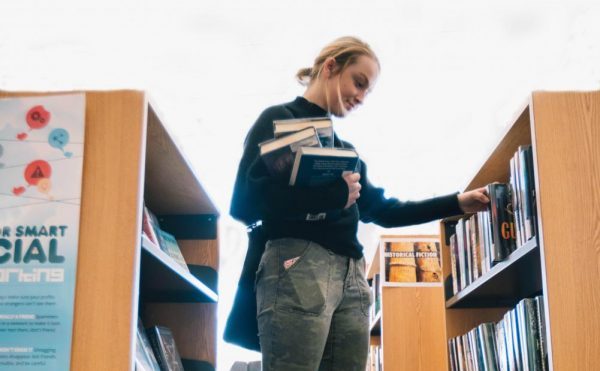BSM strives to promote reading
With the new rise in technology, many aspects of education are turning digital and reading can be overlooked; however, many BSM students prefer to read physical books when reading in their free time.

Even though technology has changed reading, many students still prefer to read books in print.
With the new age of technology, reading and traditional styles of learning have changed. BSM’s English department strives to keep up with technology in order to increase student comprehension of material and foster a constantly improving English department in order to not just increase student comprehension of material, but to foster a greater appreciation of literature among students.
The Search Institute––an American non-profit organization that starts national youth projects––lists reading for pleasure as one of the key developmental aspects that young people need to be successful, happy and well-adjusted. Studies at University of California, Berkeley, and Stanford University found that reading increases overall brain function, and improves memory.
BSM students find that reading is an important skill for many reasons. It can provide insight on big topics, as well as entertain. “I feel like [reading] is important, because if you don’t know how to read you don’t know what’s going on in the world,” junior Ryan Norkosky said.
In addition to being a teaching tool and keeping people informed, some students read because it can allow the opportunity to escape. “It’s another world where you can be anything that you want––you can be someone other than yourself and do extraordinary things that aren’t possible in the real world. Also ‘cause it’s fun,” senior Ellie Krueger said.
However, reading is no longer the same as it once was. The normalization of handheld devices such as smartphones, tablets, and smartwatches have fundamentally changed the way society finds and consumes media. Being able to access, buy and download books online has caused competition to break out between businesses in terms of paperback versus electronic products. “I do a lot of electronic reading, especially being a sports fan, there are columnists that I follow––it’s not just the local paper anymore-whether that’s small write-ups to oral histories of some events. If not, I’m reading a book, then I buy paperback,” Mr. Bill Cheney, BSM’s Help Desk Manager, said.
For a while it seemed that ebooks were overtaking traditional print, but recent 2017 articles suggest otherwise––as it seems that younger generations are increasingly seeking physical books, while ebook sales fall. “I always had this feeling that you wanted to buy the CD or buy the t-shirt from the band to support them financially. So, I try to make it a point to go to a local bookstore and order a copy of a book from them, because its a two-bird, one stone deal, because I’m supporting a local business and the author,” Cheney said.
Many students still prefer using physical books as opposed to using an ebook because they provide a different reading experience. In addition, students are used to physical books as they are constantly used in school. “I like the way the pages feel and the way the book smells,” senior Sally Calengor said.
A common debate among the literary and educational communities is which is more beneficial: paperback books or ebooks. Online books are more accessible to younger readers due to their portability, but physical books increase retention and can be helpful to avoid eye strain. Many claim that paperback books make material easier to connect with for students, while others say that the most convenient and approachable method can foster a stronger connection. “I think that it comes down to how the individual wants to treat the assessment, and the book. If I had my own iPad that was just full of books, and it had notifications off, and it was just there to read and annotate, I think you’d get just as attached as when you have a book. I think where it gets difficult is when I’m three pages in to the chapter, and my friends texts me a meme, and now we’re texting back and forth,” Cheney said.
A Knight Errant survey of nearly 100 BSM students revealed results in favor of reading in print with 42.9% preferring paperback in contrast to 7.1% of students that read primarily online; 50% of students read both. The survey found students usually read for fun between 15 to 30 minutes each day.
Cheney has noticed teachers working hard to adapt curriculum to the ever rising use of technology. “Our teachers do a great of job of making sure they’re finding new tools to help keep us moving forward. Especially in the last couple years they’ve found some really great tools to help us adapt. Especially with reading, everyone is at a slightly different level–not everyone reads the same–and they’ve found some great programs that adapt text online to your reading level,” Cheney said.
Along with all the technological advancements, the state of modern literature is very different than how it was five, or ten years ago. With society’s ever changing nature, art follows suit. Ms. Calli Olson, a BSM English teacher, acknowledges how much BSM’s English program has to adapt to current trends and ideas. “We’re trying to add more book circle type projects, where kids are getting to choose their own books, and adding in some more ninth grade friendly content–so more identity type books, and coming-of-age type novels, so those are the things we are working on bringing into ninth grade. Because, right now it’s pretty canonical. We read a lot of the old school type literature, or the classics. Which, they are classics, but we are trying to update and add more contemporary texts,” Olson said.
Olson believes that reading the classics is still essential, but also believes that students can use modern texts as a gateway to gaining comprehension and appreciation for the older conventions of literature. “I think contemporary novels can be a nice bridge to understanding classic novels, because kids buy into it a little easier. Students, especially ninth grades, they’re very––and I don’t say this derogatorily––they’re self-centered, because psychologically that’s where their brain is. They are looking for anything that they can connect themselves to. If they can connect themselves to a novel like Long Way Down, which is a novel about generational cycles of violence, so that connects really really well with Romeo and Juliet. If we teach Long Way Down first, then I can bring those concepts into Romeo and Juliet. It makes Shakespeare much easier to connect to because it makes more sense for the kids’ life,” Olson said.
There are differences in how certain age groups consume literature. “Weirdly, I think that tenth graders are more reluctant readers than the ninth graders. Partially, it’s because of the age that they are. Ninth graders are still kind of hedging their bets with teachers. Tenth grade is more ‘I want to be my own individual––but I don’t know how yet, so I’m just gonna buck the system and refuse to do what people are telling me I should do.’ This is why, in English 10, I try to find a theme throughout all our books, and a theme that tenth graders can connect with,” Olson said.
While some are reluctant to read, it has many proven benefits. “Research shows pleasure reading can help in cognitive and social development and also reduce stress and improve self esteem,” Ms. Laura Sylvester, BSM’s librarian, said.
A separate survey revealed that 71.4% still read for pleasure while 28.6% say that they don’t read for pleasure. Despite this, 65.3% of students answered that they read less than they used to when they were younger. “I think a lot of kids think that they just don’t like to read because they haven’t found a book that they enjoy yet, or they haven’t been introduced to a genre that makes sense to them yet. So, diversity in type and style, which includes diversity of authors and voices, is the best way to become a well-rounded reader,” Olson said.




































![Teacher Lore: Mr. Hillman [Podcast]](https://bsmknighterrant.org/wp-content/uploads/2025/03/teacherlorelogo-1200x685.png)





